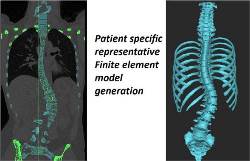ongoing research projects
-Anterior Cruciate Ligament (ACL) Injury Mechanisms
ACL Injury Mechanisms
Summary: ACL is one of the most common sites of the injury in the knee joint. Over
100,000 ACL injuries occur annually in the United States, mainly affecting the young
athletic population. Non-contact injuries are reported to be the predominant mechanism
of ACL injury (occur in more than 70% of the ACL injuries). These injuries involve
ground reaction forces, muscle forces and segmental inertia without the presence of
any external load applied to the body, especially during landing activities. Due to
Long term disabilities associated with ACL injury (i.e. joint instability, pain and
early development of osteoarthritis), potential loss of sports participation and high
costs associated with the surgical reconstruction, prevention is an appealing option
to avoid the complications associated with ACL injury. While many advances have been
made in terms of surgical and rehabilitation treatments for ACL injured patients,
long term outcome studies have shown that these patients are at a high risk for developing
knee osteoarthritis 10-15 years after ACL injury regardless of treatment. Currently,
the mechanism of non-contact ACL injury is not well understood. A better understanding
of the mechanisms underlying non-contact ACL injuries, associated modifiable and non-modifiable
risk factors, and interaction between these risk factors, might be used to improve
current prevention strategies and decrease the risk of early-onset osteoarthritis.
This project utilizes a unique blend of established in vitro, in silico and in vivo
methods in order to gain an in depth understanding of knee joint biomechanics during
dynamic landing (as an identified high-risk task) with a specific focus on ACL injury.
Principle Investigators: Vijay Goel, Ph.D
Research Fellow: Ali Kiapour, Ph.D.
Assistant Research Professor: Deniz Erbulut, Ph.D
Research Assistants: Sara Sadeqi, M.S & Rodney Summers, M.S.
Collaborator: Timothy E. Hewett, Ph.D, (Mayo Clinic)
Funded by: National Institutes of Health (NIH)-NIAMS







-Juvenile Idiopathic Scoliosis
Summary: Progression of scoliosis in children poses a substantial challenge for spinal
surgeons. These young patients are undergoing active growth; hence early fusion of
any kind would stunt their growth and have untoward affect on their quality of life.
However, if left untreated, a major curve progression is imminent with chances of
respiratory insufficiency. This led to an advent of growth friendly surgical management
of early scoliosis. These growth friendly surgical treatment aim to avoid, delay or
limit spinal fusion. They are classified as distraction-based (i.e., growth rods,
vertical expandable prosthetic titanium rib, guided growth and compression-based techniques.
Distraction-based growth rods are most commonly used growth friendly surgical instrumentation.
Despite many advantages of this system, there have been many instances of failure,
both mechanical and biological, have been reported in the literature. The implant
here is under longer duration of higher stress than fusion-based implants which increases
their propensity towards mechanical failure. The most common biological failures are
spontaneous fusion and the whole cascade of degenerative changes in the instrumented
and neighboring regions of the spine. The above failure may lead to failure of growth
or abnormal growth. We are studying the biomechanical differences of using these instrumentation
taking growth modulation and bone remodeling into account.
Principle Investigators: Vijay K. Goel, Ph.D.; Anand Agarwal, M.D.
Research Assistant: Aakash Agarwal, Ph.D., Ardalan Seyed Vosoughi, B.S.
Undergraduate: Jacob Forstat
Collaborator: Arvind Jayaswal, M.D., (Department of Orthopaedics,
All India Medical Institute of Sciences)


NSF-I/UCRC CDMI PROJECTS
Development of an innovative posterior pedicle-based screw device for multilevel semi-dynamic stabilization. PI & Presenter: Dr. Deniz U. Erbulut
Development of Hard Antibacterial (TiN/Ag) Coatings on Orthopedic Instruments Fabricated
from Ti-alloys. PI: Dr. Sarit B. Bhaduri, Ph. D.
Presenters: A. Jayatissa & Lufei Lu
Biomechanical Evaluation of the Newly Developed Decompression Surgery: Transforaminal
Ventral Facetectomy. PI: Vjay Goel, Koichi Sairyo, MD
Presenter: Koji Matsumoto, MD
Transporter Table System. PI: Anand Agarwal, MD
Presenter: David Dick
Biomechanical Evaluation of the Newly Developed Decompression Surgery: Transforaminal
Ventral Facetectomy. Effect of Talotarsal Joint Instability on Lower Extremity Alignment
and the Role of Extra-osseous Talotarsal Joint Stabilization.
PI: Michael E. Graham; Vijay Goel
Presenter: Koji Matsumoto, MD
Tapered reduction of cement volume in the proximal vertebrae adjacent to the fused segment may translate into a decreased rate of Proximal Junctional Kyphosis (PJK) using Calcium phosphate cement - A biomechanical investigation. PI: Anand Agarwal MD Presenter: Anoli Shah
Orthopaedic Biomechanics (Joint Mechanics and Injury Mechanics)
Biomaterials and Tissue Engineering
Bone Biology
Clinical Evaluation (retrospective and prospective clinical studies)
Assistive Technologies
Ongoing Projects
Sponsors
Publications
Awards


